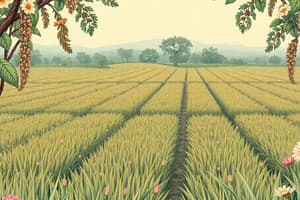Podcast
Questions and Answers
Land under agriculture is decreasing day-by-day. What are the consequences?
Land under agriculture is decreasing day-by-day. What are the consequences?
Land has been decreased due to the ever increasing population, Reduced production, Increasing poverty of farmers, Endangering food security, Non-receipt of raw materials to industries.
Write the salient features of Kharif season crops.
Write the salient features of Kharif season crops.
Kharif crops are sown in different regions of the country with the arrival of monsoon and are harvested in September and October. The main crops sown in this season are rice, maize, jowar, bajra, turmoong, urad, cotton, jute, groundnut, and soyabean. They are also known as monsoon crops.
What is meant by food crops? Explain the differences between Kharif and Rabi crops?
What is meant by food crops? Explain the differences between Kharif and Rabi crops?
By food crops, we mean those crops which are main sources of food items. Food crops include cereals and pulse such as rice, wheat, jowar, maize, millet, gram, tur and other pulses. The main difference between Kharif and Rabi crops is the season in which they are grown. Kharif crops are grown during the monsoon season, while Rabi crops are grown during the winter season.
Kharif crop season starts with the arrival of?
Kharif crop season starts with the arrival of?
Main crops grown in the Kharif season?
Main crops grown in the Kharif season?
Kharif crops take less time to ripen compared to Rabi crops.
Kharif crops take less time to ripen compared to Rabi crops.
The per hectare production of Kharif crops is high.
The per hectare production of Kharif crops is high.
Kharif crops are harvested in?
Kharif crops are harvested in?
Rabi crop season starts with?
Rabi crop season starts with?
Main crops of the Rabi season are?
Main crops of the Rabi season are?
Rabi crops take less time to ripen.
Rabi crops take less time to ripen.
The per hectare production of Rabi crops is generally high.
The per hectare production of Rabi crops is generally high.
What are the factors promoting globalization in India?
What are the factors promoting globalization in India?
What is Buffer Stock?
What is Buffer Stock?
Flashcards
What is a Mineral?
What is a Mineral?
A naturally occurring substance with a specific chemical composition and crystal structure.
Koderma's Mineral Wealth
Koderma's Mineral Wealth
Koderma, located in Jharkhand, is known for its mineral deposits.
Minerals in Sedimentary Rocks
Minerals in Sedimentary Rocks
Sedimentary rocks often contain mineral deposits.
High-Grade Iron Ore %
High-Grade Iron Ore %
Signup and view all the flashcards
Power Plant Fuel
Power Plant Fuel
Signup and view all the flashcards
India's largest coal field
India's largest coal field
Signup and view all the flashcards
State that produces coal
State that produces coal
Signup and view all the flashcards
State that produces Iron
State that produces Iron
Signup and view all the flashcards
What is Bauxite?
What is Bauxite?
Signup and view all the flashcards
What is Lime stone?
What is Lime stone?
Signup and view all the flashcards
What are coal fields?
What are coal fields?
Signup and view all the flashcards
What is Chhattisgarh?
What is Chhattisgarh?
Signup and view all the flashcards
What is Lignite?
What is Lignite?
Signup and view all the flashcards
What is Aluminium?
What is Aluminium?
Signup and view all the flashcards
What is Nickel?
What is Nickel?
Signup and view all the flashcards
What is oil?
What is oil?
Signup and view all the flashcards
What are metamorphic rocks?
What are metamorphic rocks?
Signup and view all the flashcards
Fuel minerals
Fuel minerals
Signup and view all the flashcards
The buried Rocks
The buried Rocks
Signup and view all the flashcards
Describing minerals
Describing minerals
Signup and view all the flashcards
Study Notes
- India is a leading producer and exporter of tea, ranking second only to China as of 2015-2016.
- Land under agriculture is decreasing due to increasing population, leading to:
- Decreased land size
- Reduced production
- Increased poverty for farmers
- Endangering food security
- Non-receipt of raw materials for industries
Kharif Crops
- Kharif crops are sown with the onset of the monsoon season in different regions and harvested in September-October.
- Main Kharif crops include rice, maize, jowar, bajra, turmoong, urad, cotton, jute, groundnut, and soyabean.
- Kharif crops are also known as monsoon crops.
- Kharif crops include cereals and pulses such as rice, wheat, jowar, maize, millet, gram, tur, and other pulses, which serve as main sources of food items.
- Kharif season starts with the arrival of the monsoon.
- Kharif crops take less time to ripen.
- Per hectare production of Kharif crops is low.
Rabi Crops
- Rabi crops are sown in autumn after the monsoon season and harvested in March-April.
- Main Rabi crops include wheat, barley, gram, mustard, and linseed like oilseeds.
- Rabi crops take a relatively longer time to ripen.
- .Per hectare production of Rabi crops is high.
Factors Promoting Globalisation in India
- Technological improvements in the past 50 years, such as container use in transportation, have reduced costs and increased speed to reach markets.
- Telecommunication facilities enable global communication and allow for instant electronic mail at negligible costs.
- The Indian government's removal of trade barriers, called liberalization, has facilitated the export and import of goods and services
- This has permitted multinational corporations to establish factories and offices in India, fostering greater integration of production and markets across countries.
Buffer Stock
- Buffer stock is the reserve of food grains, specifically wheat and rice, stored in granaries.
- It is produced by the government through the Food Corporation of India (FCI) from states with surplus production.
- Farmers receive a pre-announced price for their crops, known as the Minimum Support Price.
Studying That Suits You
Use AI to generate personalized quizzes and flashcards to suit your learning preferences.




